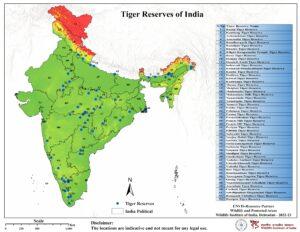Table of Contents
Tiger Reserves in India: the Bengal Tiger is considered as the National animal of India. It was declared under the project tiger in India initiative of the central government. Tiger Reserves in India are governed by the National Tiger Conservation Authority (NTCA) as per the guidelines of project tiger. Tiger Reserves in India List consists of the tiger reserve names, states and their area.
Tiger Reserves in India List
The tiger reserves of India were set up in 1973 and are governed by Project Tiger, which is administrated by the National Tiger Conservation Authority. Till now, NTCA has declared 53 protected areas as designated tiger reserves in India. The Guru Ghasidas National Park and Tamor Pingla Wildlife Sanctuary have been united to form India’s newest tiger reserve. Guru Ghasidas National Park and Tamor Pingla Wildlife Sanctuary is located in Chhattisgarh. It is the fourth tiger reserve in Chhattisgarh and the 53rd tiger reserve in all of India.
Tiger Reserves and Total Tigers in India
India is home to about 80% of the world’s tigers. In 2006, there were around 1,400 tigers in the country, and by 2018, that number had risen to nearly 3,000. Specifically, the tiger counts were 1,411 in 2006, 1,706 in 2010, 2,226 in 2014, and 2,967 in 2018 across various parts of India.
Madhya Pradesh has the highest number of tigers, with 526 young tigers (around 1.5 years old) and over 408 adult big cats. Other states with significant tiger populations include Uttarakhand (442), Karnataka (524), Tamil Nadu (229), Maharashtra (190), Assam (167), Kerala (136), and Uttar Pradesh.
List of Tiger Reserves in India
Total tiger reserves in India are 53 in number. Names of these 53 tiger reserves in India are listed below. Following the updated list of tiger reserves in India.
| List of tiger reserves in India | |||
| Sr. No. | Name of Tiger Reserve | State | Total area(In Sq.Kms.) |
| 1 | Nagarjunsagar Srisailam (part)* | Andhra Pradesh | 3296.31 |
| 2 | Namdapha | Arunachal Pradesh | 2052.82 |
| 3 | Kamlang Tiger Reserve | Arunachal Pradesh | 783 |
| 4 | Pakke | Arunachal Pradesh | 1198.45 |
| 5 | Manas | Assam | 3150.92 |
| 6 | Nameri | Assam | 344 |
| 7 | Orang Tiger Reserve | Assam | 492.46 |
| 8 | Kaziranga | Assam | 1173.58 |
| 9 | Valmiki | Bihar | 899.38 |
| 10 | Udanti-Sitanadi | Chattisgarh | 1842.54 |
| 11 | Achanakmar | Chattisgarh | 914.01 |
| 12 | Indravati | Chhattisgarh | 2799.07 |
| 13 | Palamau | Jharkhand | 1129.93 |
| 14 | Bandipur | Karnataka | 1456.3 |
| 15 | Bhadra | Karnataka | 1064.29 |
| 16 | Dandeli-Anshi | Karnataka | 1097.51 |
| 17 | Nagarahole | Karnataka | 1205.76 |
| 18 | Biligiri Ranganatha Temple | Karnataka | 574.82 |
| 19 | Periyar | Kerala | 925 |
| 20 | Parambikulam | Kerala | 643.66 |
| 21 | Kanha | Madhya Pradesh | 2051.79 |
| 22 | Pench | Madhya Pradesh | 1179.63 |
| 23 | Bandhavgarh | Madhya Pradesh | 1598.1 |
| 24 | Panna | Madhya Pradesh | 1578.55 |
| 25 | Satpura | Madhya Pradesh | 2133.30 |
| 26 | Sanjay-Dubri | Madhya Pradesh | 1674.50 |
| 27 | Melghat | Maharashtra | 2768.52 |
| 28 | Tadoba-Andhari | Maharashtra | 1727.59 |
| 29 | Pench | Maharashtra | 741.22 |
| 30 | Sahyadri | Maharashtra | 1165.57 |
| 31 | Nawegaon-Nagzira | Maharashtra | 653.67 |
| 32 | Bor | Maharashtra | 138.12 |
| 33 | Dampa | Mizoram | 988 |
| 34 | Similipal | Odisha | 2750 |
| 35 | Satkosia | Odisha | 963.87 |
| 36 | Ranthambore | Rajasthan | 1411.29 |
| 37 | Sariska | Rajasthan | 1213.34 |
| 38 | Mukandra Hills | Rajasthan | 759.99 |
| 39 | Kalakad-Mundanthurai | Tamil Nadu | 1601.54 |
| 40 | Anamalai | Tamil Nadu | 1479.87 |
| 41 | Mudumalai | Tamil Nadu | 688.59 |
| 42 | Sathyamangalam | Tamil Nadu | 1408.4 |
| 43 | Kawal | Telangana | 2019.12 |
| 44 | Amrabad | Telangana | 2611.39 |
| 45 | Dudhwa | Uttar Pradesh | 2201.77 |
| 46 | Pilibhit | Uttar Pradesh | 730.24 |
| 47 | Amangarh (buffer of Corbett TR) | Uttar Pradesh | 80.6 |
| Corbett | Uttarakhand | 1288.31 | |
| 48 | Rajaji TR | Uttarakhand | 1075.17 |
| 49 | Sunderbans | West Bengal | 2584.89 |
| 50 | Buxa | West Bengal | 757.90 |
| 51 | Srivilliputhur Megamalai | Tamil Nadu | 1016.57 |
| 52. | Ramgarh Vishdhari Wildlife Sanctuary | Rajasthan | 252 |
| 53. | Guru Ghasidas National Park and Tamor Pingla Wildlife Sanctuary | Chhattisgarh | 466.67 |
Tiger Reserves in India Map
We have also provided you with the map of 53 tiger reserves in India. This Tiger reserves of India map is provided by the wildlife institute of India and published by NTCA also on its website.

Latest Tiger Reserve in India
The combined lands of the Tamor Pingla Wildlife Sanctuary and the Guru Ghasidas National Park was designated as a Tiger Reserve by the NTCA’s Technical Committee in October 2021. The Guru Ghasidas National Park and Tamor Pingla Wildlife Sanctuary together has a total 1,440 and 608 square kilometres, respectively. The year 2011 saw the addition of the Tamor Pingla Wildlife Sanctuary to the Sarguja Jashpur Elephant Reserve. So, this became the fourth tiger reserve in Chhattisgarh and the 53rd tiger reserve in all of India.
Top 10 Largest Tiger Reserves in India
Nagarjunsagar Srisailam
Nagarjunsagar Srisailam Tiger Reserve is one of the largest tiger reserves in India, covering an area of 3,296.31 square kilometers across the states of Telangana and Andhra Pradesh. This reserve spans five districts and features the beautiful Nallamala Hills.
- The reserve also includes the multipurpose reservoirs of Srisailam and Nagarjunasagar.
- Flora and Fauna: It is home to a diverse range of wildlife, including the Bengal tiger, leopard, pangolin, and Indian rock python.
Manas National Park
Manas National Park is second largest tiger reserve in Indian which is located in the Himalayan foothills in Assam. Manas National Park is spread over 3150.92 sq.km. in area. The park is known for its rare and endangered endemic wildlife.
- Manas National Park has also been listed as a UNESCO World Heritage Site, Tiger Reserve, Elephant Reserve, Biosphere Reserve, and National Park.
- Fauna: It is home to a variety of species of fauna such as One-horned Rhinoceros, Asiatic Elephants, Indian Tigers, Clouded leopards, Hoolock Gibbons, and Barking Deer, etc.
Melghat Tiger Reserve
Melghat Tiger Reserve is located on the southern offshoot of the Satpura Hill Range in Central India, called Gavilgarh hill in the Indian state of Maharashtra. Melghat Tiger Reserve is spread over 2768.52 sq.km. in area. It is the prime habitat of the tiger and the prime biodiversity repository of the state. This tiger reserve is also a catchment area of five major rivers.
Similipal National Park
Simlipal National Park is a national park and a tiger reserve in the Mayurbhanj district in the Indian state of Odisha. Similipal National Park is spread over 2750 sq.km. in area.
- Flora and Fauna: The area of Simlipal reserve is gifted with great bio-diversity and ultimate varieties of faunas in the ranges with the ambience of cool breeze emerging out of the dense forests. There are many small waterfalls that add character to the Royal Bengal Tiger in the reserve.
Amrabad Tiger Reserve
Amrabad Tiger Reserve lies in the Nallamala hills of Telangana. It has a large presence of the Chenchu tribe. Amrabad Tiger Reserve is spread over 2611.39 sq.km in the state of Telangana.
- It harbours great biodiversity, consisting of around 70 species of mammals, more than 300 hundred avian varieties, 60 species of reptiles, and thousands of insects, all supported and nourished by more than 600 different plant species.
- The fauna in this tiger reserve are Bengal Tiger, leopard, rusty-spotted cat, pangolin, Mugger Crocodiles, Indian Rock Python, and innumerable varieties of birds are found here.
Sunderbans Tiger Reserve
Sundarban the world’s largest delta is located in India and Bangladesh. Sundarbans National Park is located in the southern part of West Bengal. Sunderbans Tiger Reserve is spread in 2584.89 sq.km. in the state of West Bengal.
- Sundari trees can be found in abundance in this forest.
- The Royal Bengal tigers are well-known in Sundarban.
- This national park is designated by UNESCO as World Heritage Site and well known for the conservation of Tiger under Project Tiger.
Dudhwa Tiger Reserve
The Dudhwa Tiger Reserve is a protected area in Uttar Pradesh located on the India-Nepal border. It stretches mainly across the Lakhimpur Kheri and Bahraich districts. The Dudhwa Tiger Reserve is spread in 2201 sq.km. area.
- Flora and Fauna: The Dudhwa National Park has a number of species of birds, reptiles, wild elephants, aquatic animals, one-horned rhinos, and wild elephants besides its enriched flora and fauna. Its undisturbed natural forest cover, vast spans of grasslands, and wetlands.
- It is the only place in U.P. where both Tigers and Rhinos can be spotted together.
Satpura Tiger Reserve
Satpura Tiger reserve is located in the south of River Narmada in the district of Madhya Pradesh. Satpura National Park is rich in biodiversity. Satpura Tiger Reserve is spread across 2133.30 sq.km. in area.
- Fauna: The animals here include leopard, sambar, chital, Indian muntjac, nilgai, four-horned antelope, Chinkara, wild boar, bear, black buck, fox, porcupine, flying squirrel, mouse deer, and Indian giant squirrel.
Namdapha Tiger Reserve
Namdapha Tiger Reserve is located in the Changlang district in Andhra Pradesh. Namdapha Tiger Reserve is spread in 2052.82 sq.km. area in the state of Andhra Pradesh.
- It is the only park in the World to have the four Feline species of big cat namely the Tiger, Leopard, Snow Leopard, Clouded Leopard, and the number of Lesser cats.
Kanha Tiger Reserve
Kanha National Park was created on 1 June 1955 and in 1973 was made the Kanha Tiger Reserve. It stretches over an area of in the two districts Mandla and Balaghat. Kanha Tiger Reserve is spread across 2051.79 Sq.km. in area.
- The park has a significant population of the Royal Bengal tiger, Indian leopards, the sloth bear, barasingha, and Indian wild dog.
Tiger Reserves in India Schemes
Various Important Government schemes/initiatives for protecting the tigers and tiger reserves are discussed below-
Project Tiger
Project Tiger was established to support the preservation of tigers in India on 1st April 1973. Project Tiger in India is a fully centrally funded program that gives money to the ‘tiger range states’ to support in-situ tiger conservation in the selected tiger reserves. The National Tiger Conservation Authority (NTCA) is entrusted with the implementation and overseeing the Project Tiger in various states.
Tiger Census
Since 2006, the National Tiger Conservation Authority (NTCA) and the Wildlife Institute of India (WII), with help from state forest agencies and conservation NGOs, have been carrying out the Tiger Census in India. This census happens every four years to track and estimate the number of tigers in the country.
M-S TrIPES
St. Petersburg Declaration on Tiger Conservation


 TSPSC Group 1 Question Paper 2024, Downl...
TSPSC Group 1 Question Paper 2024, Downl...
 TSPSC Group 1 Answer key 2024 Out, Downl...
TSPSC Group 1 Answer key 2024 Out, Downl...
 Cabinet Ministers of India 2024, New Cab...
Cabinet Ministers of India 2024, New Cab...







